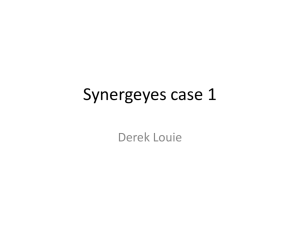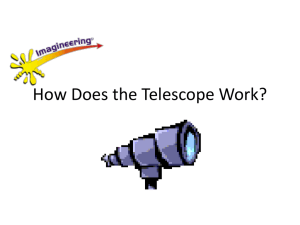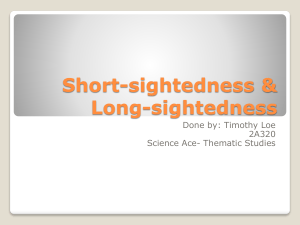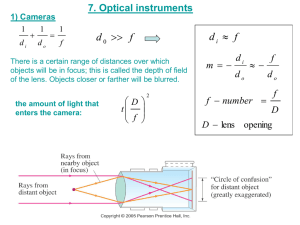Lens Power Measurement
advertisement
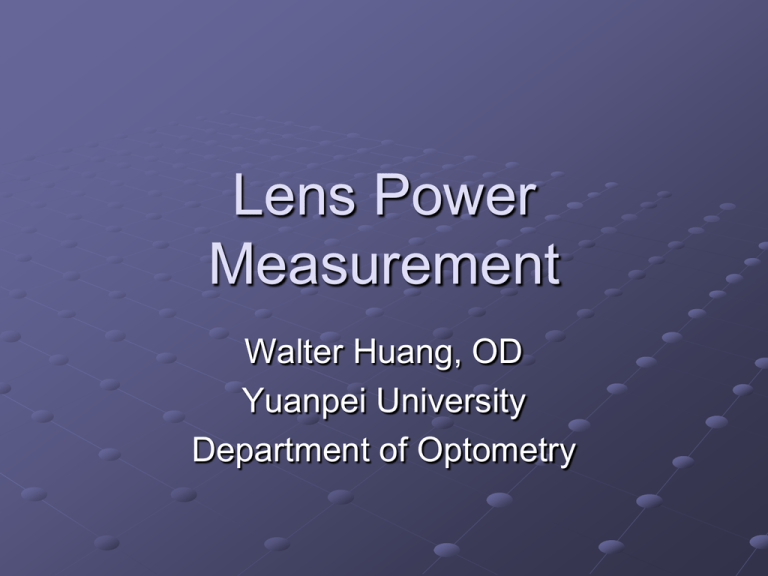
Lens Power Measurement Walter Huang, OD Yuanpei University Department of Optometry Methods of Lens Power Measurement Trial lens hand neutralization Lensometer Much greater accuracy may be obtained with the lensometer than with trial lens hand neutralization Trial Lens Hand Neutralization Two lenses neutralize each other when placed in contact with each other so that the combined power of the two lenses is equal to zero An unknown lens is neutralized by a known trial lens of equal power but opposite in sign Trial Lens Hand Neutralization Trial Lens Hand Neutralization This is performed in the absence of a lensometer It is used qualitatively as a means for estimation in many clinical and dispensing situations It often involves simply identifying if it is a plus, a minus, or a toric lens It more accurately estimates low power plus and minus lenses than toric lenses Trial Lens Hand Neutralization It is used to measure the front vertex power of the lens Trial Lens Hand Neutralization View a large distant cross target through the lens Hold lens on visual axis, at arm’s distance Align lens such that the cross target is continuous Move lens vertically, observe motion of horizontal line Move lens horizontally, observe motion of vertical line Trial Lens Hand Neutralization For a plus or a minus lens, linear motion is used to neutralize power If observe “against motion,” use plus lens If observe “with motion,” use minus lens Trial Lens Hand Neutralization For a plus or a minus lens, linear motion is used to neutralize power Trial Lens Hand Neutralization For a toric lens, rotational motion is used to find the axis If observe “against motion,” use plus cylinder axis If observe “with motion,” use minus cylinder axis Trial Lens Hand Neutralization For a toric lens, rotational motion is used to find the axis Trial Lens Hand Neutralization Place known trial lens against front surface of unknown lens No movement indicates neutrality A minus or plus lens (i.e., a spherical lens) has the same speed and direction of motion in both the vertical and horizontal meridians In the case of a toric lens (i.e., spherocylindrical lens), neutralize one limb of the cross target at a time Trial Lens Hand Neutralization Example An unknown lens is neutralized in the horizontal meridian with +3.00D and the vertical meridian with +2.00D Prescription of unknown lens: +3.00 -1.00 x 180 Power cross: Trial Lens Hand Neutralization Large distant cross target Trial Lens Hand Neutralization Plus lens Trial Lens Hand Neutralization Minus lens Trial Lens Hand Neutralization Toric lens Lensometry Definition “Lenso” = lens “metry” = measurement of Lensometer Lensometer Purpose Neutralizing a pair of glasses To determine the prescription Verifying a pair of glasses To confirm the accuracy of fabricated glasses Duplicating a pair of glasses To determine the prescription, and the lab duplicates the exact prescription Lensometer It is used to measure the back vertex power or front vertex power of the lens Lensometer To find the back vertex power, place the concave side of lens against lens stop Lensometer To find the front vertex power, place the convex side of lens against lens stop Lensometer In the case that the lens is a spherocylindrical prescription, the lensometer is used to determine the cylinder axis It is used to locate the optical center of the lens The lensometer is used to measure the amount of prism in the lens Lensometer Systems Observation system (Keplerian telescope with two plus lenses, an inverted target image) Objective lens Eyepiece (ocular lens) Reticle (concentric circles and cross hairs focused by eyepiece) Lensometer Systems Focusing system (Badal lens system) Light source Target (cross hairs) Standard lens (+20.00D) Lens stop Power wheel Lensometer Schematic Observation System The Keplerian telescope consists of an objective lens, an eyepiece, and a reticle The two plus lenses are positioned so that their two focal points coincide with each other The unknown lens whose power is to be measured or neutralized is positioned at the lens stop (the location of the secondary focal plane of the standard lens) Lensometer Operation With the instrument set at zero, an illuminated target (light source) is positioned at the focal length of a plus lens (standard lens) usually a +20.00D lens Diverging rays of light from the illuminated target are bent by the standard lens and parallel light emerges from focusing system into the observation system, which is viewed through the telescope by the observer Lensometer Operation When the lens of unknown power is introduced, the image of the illuminated target is thrown out of focus Lensometer Operation The target is movable By moving the target closer to or farther from the standard lens, the refractive power of the unknown lens can be neutralized Closer to standard lens for plus lens neutralization Farther from standard lens for minus lens neutralization Lensometer Operation The physical distance forward or backward that the target moves indicates the power of unknown lens for the meridian being measured Lensometer Anatomy Risley prism Lens holder eyepiece Lens stage Power wheel Lens stop Axis wheel Lensometer reticule target Sphere line 3 2 1 Cylinder lines Lensometer Lensometer Preparation Focus the eyepiece of the lensometer for the examiner’s eye With the power wheel set on zero, turn the eyepiece as far counter-clockwise as possible Then slowly turn it clockwise until the reticule first comes into sharp focus Lens Measurement Preparation Insert the spectacles If testing a pair of glasses, always check the right lens first Place the pair of glasses in the lensometer with the ocular surface away from you The lens is held in place by the lens holder and is held level on the lens table Center the lens by moving it so that the image of the lensometer target is aligned in the center of the eyepiece reticle Single Vision Lens Measurement To measure single vision lenses, either back vertex powers or front vertex powers must be found Single Vision Lens Measurement Determine which part of the target is used for determining the spherical component and which part of the target is used for determining the cylindrical component Rotate the power wheel until the lines (or the spots) are in clear focus If the power is spherical, all the lines (or spots) will be clear Note the power on the power wheel Types of Target Single Vision Lens Measurement If the spherical and cylindrical lines do not come into focus at the same time, the lens has a cylindrical component Rotate the power wheel until the spherical lines focus with the less minus (or more plus) power Orient the target rotation dial (axis wheel) so that the spherical lines are perfectly straight Single Vision Lens Measurement Read the power and record as the spherical component of the prescription Focus the cylindrical lines by rotating the power wheel to more minus (or less plus) power (90 degrees away) The difference in power between the two principal meridians is the amount of minus cylinder power in the lens Read the axis of the cylinder from the axis wheel Single Vision Lens Measurement Example +1.00 -2.00 x 120 Power wheel sphere setting Single Vision Lens Measurement Example +1.00 -2.00 x 120 Power wheel cylinder setting Single Vision Lens Measurement Mark the optical center (OC) Make sure that the lens is centered and the spectacle is sitting on the lens table evenly Use the OC marker on the lensometer to spot the lens Three dots will be marked The center dot marks the OC The other two dots indicate the 0 to 180 horizontal line Position and read the second lens Single Vision Lens Measurement When both lenses have been measured and marked, measure the distance between optical centers of the lenses (DBOC or geometric center distance) Multifocal Lens Measurement To measure bifocal and trifocal lenses, front vertex powers must be found This is especially true for lenses with high distance and near powers Again, front vertex power is measured by turning spectacles around with back surface of the lens toward the operator (i.e., the convex side of the lens against the lens stop) Multifocal Lens Measurement Measure the distance portion of multifocal lenses, in the same way as with single vision lenses Turn the glasses around backward so that the temples face the operator Find the distance front vertex power Find the near front vertex power Record the addition power (Add), which is the difference between the distance and near prescriptions Prism Changes direction of light going through a lens Prism Purpose To treat a binocular vision problem To shift the visual field To improve the lens appearance through prism thinning Prism It is often divided equally between the two lenses of spectacles for balance and aesthetic reasons Types of Prism Horizontal prism Base in (BI) Base out (BO) Vertical prism Base up (BU) Base down (BD) Oblique prism A combination of horizontal and vertical prisms Types of Prism and Lens Methods of Achieving Prism in Lens Grinding Usually applied when a large amount of prism is required Lens is custom-made Optic center is often not on lens Decentration Usually applied when a small amount of prism is required With spherical prescription, it is easier to deal with decentering than with spherocylindrical prescription Prism Measurement The purpose is to verify if the prescription contains the desired prismatic effect Verification of prism in prescription is done similarly to measurement of lens power using the lensometer The only difference is in the means by which the target is positioned in the lensometer Prism Specification Prism Verification To verify the prescribed prism when the amount of prism is known The center of the illuminated target is positioned at the location on the circular mires corresponding to the prism required Prism Verification Example 1: If the right lens calls for 2 prism diopter BU, then the illuminated target would be positioned at the “2” ring above the center of the mires Prism Verification Example 1: Prism Verification Example 2: If both lenses contain 1.5 prism diopter BO, then the target would be placed at the 1.5 ring to the left of the center of the mires for the OD lens and to the right of the center of the mires for the OS lens Mark the major reference point (MRP) with the OC marker and measure the distance between the MRP of the lenses (i.e, the patient’s distance PD) Prism Verification Example 2: Prism Measurement In an unknown lens Patient may come in with a prescription that you are not sure if it contains prism in the lenses After power of the lenses are neutralized and the optic centers are marked, measure the distance between the optic centers (DBOC) If DBOC does not equal to the patient’s distance PD, then there is prism in the lens Prentice’s Rule P=d*F P = prism power (in prism diopters) d = decentration (in cm) F = refracting power of the lens (in diopters) Prentice’s Rule Example: Rx = -4.00DS OU Patient’s distance PD = 62mm DBOC = 72mm P=d*F = (72 – 62mm)/2 x 1cm/10mm * (-4.00D) = 0.5cm * (-4.00D) = 2 prism diopters BI in each lens Prentice’s Rule Example: Recording Record the prescription for each lens separately Record the amount of induced prism in each lens, if applicable Recording Example 1 OD -3.00DS OS -1.50 -0.75 x 180 Add +2.00 Add +2.00 Recording Example 2 OD +2.50 -0.75 x 080 OS +1.00 -0.25 x 110 2 prism diopter BI 2 prism diopter BI



